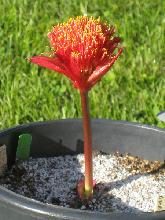Albino Flowers?
An interesting discussion erupted in the Spring in the Trillium-L list about the question, just what constitutes an albino flower in the Trillium?
I have my own set of definitions, and I reproduce some of my comments to that list herewith:
What I mean by "albino" is an individual plant or animal that has a mutation that blocks the biosynthesis of a particular class of pigment throughout the entire organism. This would be a mutation that inactivated the gene or gene product. Gene products that are enzymes are what I mean, enzymes that carry out one step in the formation of one product on the pathway to a pigment. Let's refer to genes that code for enzymes as "Structural Genes."
There are other kinds of genes as well -- regulatory genes that directly or indirectly control the synthesis or activity of structural genes or their gene products. Regulatory genes can code for proteins, for RNAs, or they may just be gene promoters, sequences that promote or inhibit the activation of another gene. Regulatory genes make up the differences in color pattern in multicolored flowers, e.g., in Dutch amaryllis like 'Apple Blossom'. The red purple ovary in Trillium erectum album is an example of regulatory genes at work, turning the red color (anthocyanin) biosynthesis pathway "ON" in the ovary and "OFF" in the petals.
If a plant has white flowers but has any pink, orange, or red anywhere else in the plant, it is not a "albino" by my definition.
Note that there are numerous ways to use the term "albino" in regard to plants. A seedling that is totally lacking in chlorophyll is termed an albino, but in this case in regard to the synthesis of functional chloroplasts that contain normal chlorophyll. In the absence of human intervention (e.g., putting the seedling into tissue culture) this is an eventually lethal mutation.
I think that a defect in the biosynthetic pathway for carotenes is probably also lethal in plants. The yellow color from carotenoids may be turned off in flower petals, but if the pathway itself is mutated and non-functional, the seedling with such a mutation probably dies quickly. So we can talk about carotene albinos but I don't think we can produce them.
So, where we are talking about flower colors and anthocyanin pigments, we can call it an "albino" if there is a Structural Gene mutation that prevents anthocyanin synthesis.
If we are talking about preventing anthocyanin synthesis in all or parts of the flowers, but not in other places -- stem, bracts (i.e., "leaves"), sepals, or fruit, we are dealing with operation of Regulatory Genes, and we cannot call those "albino."
Summer's End
The summer, especially July, was cooler than usual. There were many chilly nights. The result was that some Haemanthus started blooming in early August. In August, the Lycoris bloomed, pretty much on schedule. Now at the beginning of September, a few Colchicum flowers have started to appear.
This past month saw one of my bulbs of Haemanthus namaquensis bloom for the first time ever. In fact this is my first-ever bloom on Haemanthus namaquensis. This plant was grown from seed provided by Silverhill Seeds and planted here in 1997. The bulb is growing in a 9-in diameter by 9 inches deep pot in a very gritty mix. The inflorescence is about 7.5 inches tall, of which ca. 2.5 inches is the umbel. The leaves on this particular specimen do not have the wavy edges typical of most namaquensis.

The picture was taken on the peak day of the bloom, Aug. 31st. It's now starting to go over somewhat.
Good gardening,
Jim